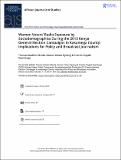| dc.contributor.author | Thomas Ibrahim Okinda, Benson Oduor Ojwang, Charles Ongadi Nyambuga | |
| dc.date.accessioned | 2021-05-21T07:02:37Z | |
| dc.date.available | 2021-05-21T07:02:37Z | |
| dc.date.issued | 2020 | |
| dc.identifier.uri | https://repository.maseno.ac.ke/handle/123456789/3785 | |
| dc.description.abstract | Sociodemographics shape audience exposure to radio. However, it remains unclear whether these sociodemographics correlate with women voters’ radio exposure during elections in Kenya. Grounded in political mobilization, uses and gratification theories, this paper examines women voters’ exposure to political information on radio during the 2013 Kenya general election campaigns in Kakamega County. The study adopted a descriptive correlational survey based on data collected from women voters in six constituencies in Kakamega County using a questionnaire (N = 372). It was established that weekly political news exposure through radio for almost three-fifths (58.6%) of women voters was 12–56 h. Respondents’ radio exposure was statistically significantly and strongly linked to their age, marital status and level of education. Further, this radio exposure was statistically significantly and moderately associated with women voters’ employment status, income and residential location. Using these demographic data, this article explores research implications and recommends the adoption of policies and practices that can better harness the power of radio to reach women as voters in counties in Kenya. | en_US |
| dc.publisher | African Journalism Studies | en_US |
| dc.subject | Broadcasting policyelection campaignsKenyasociodemographicswomen votersradio exposureaudience researchgender equality | en_US |
| dc.title | Women Voters’ Radio Exposure by Sociodemographics During the 2013 Kenya General Election Campaigns in Kakamega County: Implications for Policy and Broadcast Journalism | en_US |
| dc.type | Article | en_US |

